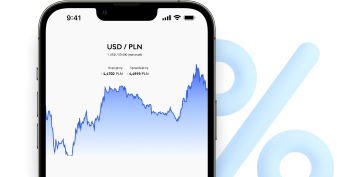Exchange rate AUD - Australian dollar
The Australian dollar is the currency of Australia, including Christmas Island, Cocos (Keeling) Islands, and Norfolk Island, as well as the independent Pacific Island states of Kiribati, Nauru and Tuvalu. It is subdivided into 100 cents.
Select currencies and check rates
Live rates.
Update: 30s
| Currency | Buy | Sell | Name | Currency code |
|---|---|---|---|---|
| AUD PLN | 2.4035 | 2.4511 | Australian dollar | 1 AUD |
Australian dollar exchange rate - chart
Last currency comments
Over 900 000 reviews
Customers rate us 4.9/5.0.*
Start saving today
Forget about unfavourable rates and hidden fees. See how much you can save. Create a free account and start converting currency online.
Open account for freeAustralian dollar
The Australian dollar (AUD) is the legal tender unit of Australia and several island nations. In everyday speech, it is referred to as "Aussie". The abbreviation is identical to that of the U.S. dollar ($), so sometimes the prefix A or AU is added to distinguish it.
The Australian dollar - where is it used?
The Australian dollar is the official currency mainly in Australia and its external territories. It is also valid in some island countries, such as Kiribati, Nauru and Tuvalu. When going to one of these more or less exotic places, it is worth checking the AUD exchange rate.
The history of the Australian dollar
The Australian dollar is a relatively young currency. It was introduced in Australia in 1966. Previously, the Australian pound was used there, which, like the British pound, was divided into 20 shillings and each shilling into 12 pence. This division was rather cumbersome to use, so in the case of AUD, it was decided to have standard hundredths of a dollar - cents. However, before the introduction of the Australian dollar, there were other ideas as well. It was suggested, among other things, that the new money should be based on florins. Another proposal was to divide the Australian pound into 1000 parts. There were also public consultations on the name. As a result, more than 1000 proposals appeared, among which the nickname "royal" was strongly promoted. However, this was met with strong disapproval from the public. The Australian dollar to the Australian pound exchange rate was set at 2:1.
The Australian dollar - key information
The Australian dollar is divided into 100 cents. There are coins in circulation in denominations of 5, 10, 20 and 50 cents, as well as 1 and 2 AUD. Until 1991, 1- and 2-cent coins were also used, but they were abandoned due to production costs that exceeded their value. The coins depict the currently reigning monarch, Queen Elizabeth II. They also show Australian nature, symbols of this country or even Aboriginal Australians. Australian dollar banknotes are made available in denominations of 5, 10, 20, 50 and 100 AUD. They present images of people of high merit for the country. On the 5 dollar bill, there is also an image of Queen Elizabeth II. As an interesting fact, the Australian dollar was the first-ever polymer plastic banknote in the world. The use of this material means that they do not wear out as quickly as money made from cellulose. The banknotes also have a unique transparent window in which holographic characters are printed to make them more difficult to counterfeit.
What determines the Australian dollar exchange rate?
AUD is one of the most traded currencies in the world. The Australian dollar exchange rate is strongly linked to the prices of commodities and raw materials, mainly coal and gold, which are part of Australia's export goods. The Australian dollar is popular among investors due to the country's relatively stable economic and political situation. AUD is seen as an interesting alternative to the four most frequently traded currencies in the world. Some countries keep part of their reserves in Australian dollars, so the AUD/EUR currency pair is popular, among others.






























